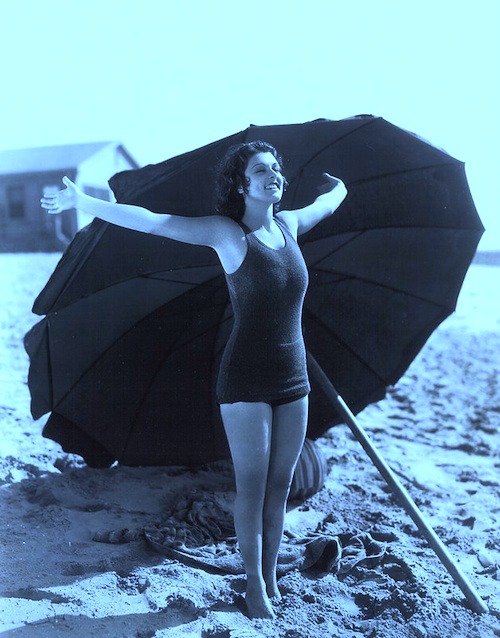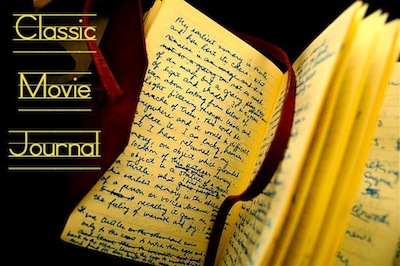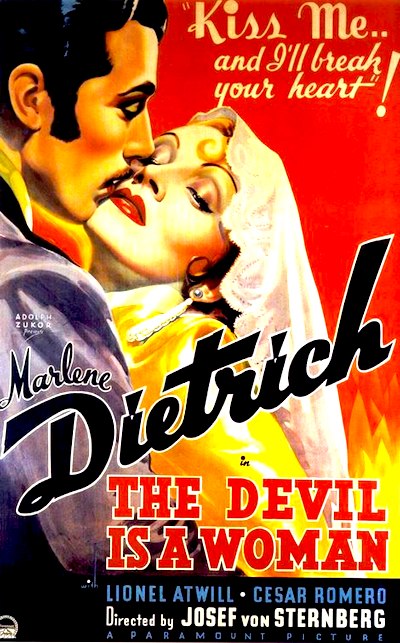
By Jennifer Baldwin. A few weeks ago I watched my new Warner Archive DVD of Madam Satan, a 1930s Pre-Code oddity extravaganza that was Cecil B. DeMille’s first and only musical. It’s famous (infamous?) for the wild costumes, Art Deco sets, bizarre musical numbers, and a spectacular finale that includes a zeppelin crash and the sight of parachuting party-goers landing in trees, Turkish baths, and the lion cage at the Central Park Zoo.
But what I really loved about the movie was that it introduced me to Lillian Roth. I didn’t even realize as I was watching it that the sexy, saucy Trixie was played by Lillian Roth of I’ll Cry Tomorrow fame. I knew that Susan Hayward played a woman named “Lillian Roth” in that 1955 biopic, but since I’d never actually seen it, I knew nothing about the real Roth. She must have been someone famous or else they wouldn’t have made a movie about her, but what exactly she was famous for I had no idea.
Well, now I know. The minute Trixie appears on screen in Madam Satan, the film starts to pop. If you want to know what I mean GO HERE TO SEE.
As the indispensable Self-Styled Siren puts it in her review of the film: “When she flings off her rumpled satin robe and twitches her pelvis to the Low Down number, the vaudeville energy of this rather plump, frowsy jazz baby ignites the entire movie.” AND HOW! I remember thinking that Lillian Roth’s Trixie was a million times sexier and spunkier than Kay Johnson’s “Madam,” the supposed “star” of the film.
So, of course, dutiful obsessive that I am, I started scouring YouTube for videos of Lillian Roth’s performances, just to see what else this sassy dame had to offer. Her voice has got the power and verve of Ethel Merman, but with a warmer tone and a bluesier, sexier bend. And she’s got charisma. Whatever that might be defined as, it shows whenever she’s on screen: she lights it up.
 Which makes her brief movie career all the more tragic. This is a woman who should have been a bigger movie star, someone who could have been in the sexy/sassy comedienne ranks with Ginger Rogers and Jean Harlow. While her honest and unflinching autobiography is justly credited with raising public awareness about alcoholism and Alcoholics Anonymous, it’s really too bad that she’s more famous for beating her addiction (and having Susan Hayward portray her) than for her talent.
Which makes her brief movie career all the more tragic. This is a woman who should have been a bigger movie star, someone who could have been in the sexy/sassy comedienne ranks with Ginger Rogers and Jean Harlow. While her honest and unflinching autobiography is justly credited with raising public awareness about alcoholism and Alcoholics Anonymous, it’s really too bad that she’s more famous for beating her addiction (and having Susan Hayward portray her) than for her talent.
Madam Satan has kicked off a Pre-Code spurt in my movie watching these days (as I write this, Night Nurse, Ladies They Talk About, Two Seconds, and The Divorcee are on my desk waiting to be devoured), so I’m excited to see that Turner Classic Movies is featuring Pre-Code goddesses Ann Dvorak and Joan Blondell in their Summer Under the Stars tributes on August 9th and August 24th, respectively.
On Ann Dvorak day, Scarface and Three on a Match are must-sees, of course, both two of the defining films of the Pre-Code era. Three on a Match, in fact, is still quite shocking, and Dvorak’s performance as a drug addicted woman is stunning and unshakable. I’m also excited for The Crowd Roars (1932), a Howard Hawks film I’ve never seen before, starring Dvorak and Jimmy Cagney as a fearless race car driver.
 On Joan Blondell day, I’m most looking forward to Sinner’s Holiday, Jimmy Cagney’s first movie role. It doesn’t hurt that the movie is about a carnival, one of my favorite movie milieus. And even though it’s not a Pre-Coder, I’m beyond stoked that TCM is showing Blondell’s movie Cry Havoc, a 1943 war drama about female nurses in Bataan.
On Joan Blondell day, I’m most looking forward to Sinner’s Holiday, Jimmy Cagney’s first movie role. It doesn’t hurt that the movie is about a carnival, one of my favorite movie milieus. And even though it’s not a Pre-Coder, I’m beyond stoked that TCM is showing Blondell’s movie Cry Havoc, a 1943 war drama about female nurses in Bataan.
Still, it’s the Pre-Coders and silent films I’m jazzed about this month, so the DVR will hum along nicely for anything made before July 1934, including Joan Blondell as a prostitute in He Was Her Man; the 24 hour tribute to Lon Chaney on August 15th; Carole Lombard day on the 28th; and Marlene Dietrich day on the 31st, including the gaudy and naughty Devil is a Woman. While not technically a Pre-Coder as generally understood, having been made in 1935, it is nonetheless filled with sex and sin, making it a kind of final hurrah for the Pre-Code era.
The thrill of both Pre-Codes and silent films is in their unsettling strangeness and pulsing energy, and in the ghostly image they provide of a shrouded, sometimes lost, past. I often feel like an Indiana Jones-style adventurer, searching for mysterious lost treasures, when I delve into the world of silent and early sound motion pictures. I recently watched Fragments: Surviving Pieces of Lost Films — a compilation of film fragments from partially lost films, including clips from the Academy Film Archive, the UCLA Film and Television Archive, and the Library of Congress — and was amazed by the footage. The world of lost and partially lost films is haunting and fascinating.
I particularly enjoy seeing the silent trailers for lost films. Not only are they the only footage we have for these films, but they show us what trailers were like in the silent era. Peep your peepers at these previews:
The Great Gatsby (1926)
Rough House Rosie (1927)
Beau Sabreur (1928)
On Trial (1928, a silent trailer for a talkie film)
It’s the lure of something old and forgotten, or only half-remembered. These lost films — mentioned in production notes and publicity stills but for which we have no surviving copies — are perhaps even more interesting than the films we do have, simply because these lost films are a mystery, shrouded in tragedy, promising something wonderful that we can only imagine.
Are the 1920s and early ’30s making a comeback in the pop culture? Film Forum has been running a series of Pre-Code films this month; Boardwalk Empire was a hit for HBO (its second season starts September 25th); and one of the biggest surprises of Cannes this past spring was the brand new silent film, The Artist (and technically, it’s a part-talkie, since there’s a dialogue scene at the end). The movie’s male lead, Jean Dujardin, won the Best Actor award at the festival in May.
The Artist (see the trailer above), from all accounts, is not a spoof of silent films, nor is it merely a tribute. Instead, it appears to be a genuine attempt at making a 21st century silent feature film. Of course, by setting the story in the past, the silent filmmaking conventions will probably seem less jarring to a modern audience. But nevertheless, this looks to be a sincere attempt to tell a cinematic story through silent movie techniques.
Thankfully, I’m not getting any indication that this will be some sort of The Good German-type fiasco, where the filmmakers try to “modernize” (a.k.a.: vulgarize and sensationalize) the world of old movies. Instead, The Artist looks like it could have been made in 1928 right alongside the films of Garbo, Fairbanks, and Keaton (hat-tip for news on The Artist to Jonas Nordin, expert blogger at “All Talking! All Singing! All Dancing!” If you want to learn about early sound cinema, he’s your man.)
The Artist is scheduled to open in the U.S. in November.
Posted on August 5th, 2011 at 11:47am.
My favorite pre-Code film is Baby Face with Barbara Stanwyck. You’ve got to check it out. Also any early Jean Harlow is unbelievable. Red Headed Woman is off the charts sassy and sexy. Even for pre-Code I don’t know how they got away with some of the scenes in the film. Good stuff!
Oh yes, Baby Face is fantastic! Love that one. It’s a hoot, too, seeing a young John Wayne as one of the guys she uses to get ahead. 😀
I really *must* see Red Headed Woman. I’ve seen some clips and it looks aces.
Thanks, Misha, for the wonderful comments!
Jennifer – I’m really impressed by the trailer for “The Artist” – I can’t wait to see it! The lead looks remarkably like Frederic March, with a touch of Douglas Fairbanks. Kudos to the filmmakers for pulling this together so beautifully. Silent film may well be my favorite style of film, so it’s nice to see that it’s glamor and mystery has not been lost on the current generation of filmmakers.
As for DeMille’s “Madame Satan,” I love the party scene on board the Zeppelin. It was DeMille hedonism and sophistication at its best! I will have to check out more of Lillian Roth’s performances – I had no idea that she was the actress being portrayed by Susan Hayward.
Speaking of rediscovered fragments of lost silent films, did you hear that they’ve rediscovered about 30 minutes of one of Hitchcock’s earliest silents, “The White Shadow”? I haven’t yet seen the footage, but I’m excited to see what it may reveal about the evolution of Hitchcock’s style.
Govindini, I can’t wait to see the footage from “The White Shadow,” as well as the John Ford film, “Upstream,” that was also found in New Zealand. What a treasure trove!
I see that Betty Compson is in the rediscovered Hitchcock; she was also in The Great Gabbo, one of the weirdest early talkies I’ve seen: Erich Von Stroheim playing a crazy ventriloquist; a creepy looking dummy named Otto; and a bizarre musical number with Betty Compson and Donald Douglas dressed up as a fly and spider, literally “caught in a web of love”! So weird! 😀
If you’re looking for more Lillian Roth, there’s Lubitsch’s “The Love Parade”; the Marx Bros. “Animal Crackers”; and “Ladies They Talk About” with Barbara Stanwyck. It’s a shame she never made any recordings back in the ’20s and ’30s. I’d kill for a record of early Lillian Roth singing.
What a loss to “The Movies.” Roth was something else; thanks for putting a spotlight on her. Makes one wonder what an alternate track of Hollywood history would have been like “if only…”
I’m struck by her speaking voice: her intonation, accent, etc. What do you know about how actresses were trained in the theater as far as their speaking style? Or was she enunciating sharply for early talkies? So many actresses and actors of that period had a similar speech pattern and it seemed to have disappeared post-WWII. Thanks.
I know what you mean about “if only…” There are so many examples throughout Hollywood history that it can get depressing if I think about it too much, heh.
As far as Roth’s speaking voice, I’m not sure if it had to do with her theater background or not. I know she was born and raised in Boston, so that may account for her particularly strong east coast accent. It would make sense that having a background in theater meant that certain actors enunciated their words more strongly, but I can’t say I know for sure.
I do know that I *love* the variety of accents and voices that we get in older movies. With the domination of television and the homogenization of American regional accents, it certainly has made today’s movies sound a lot duller.